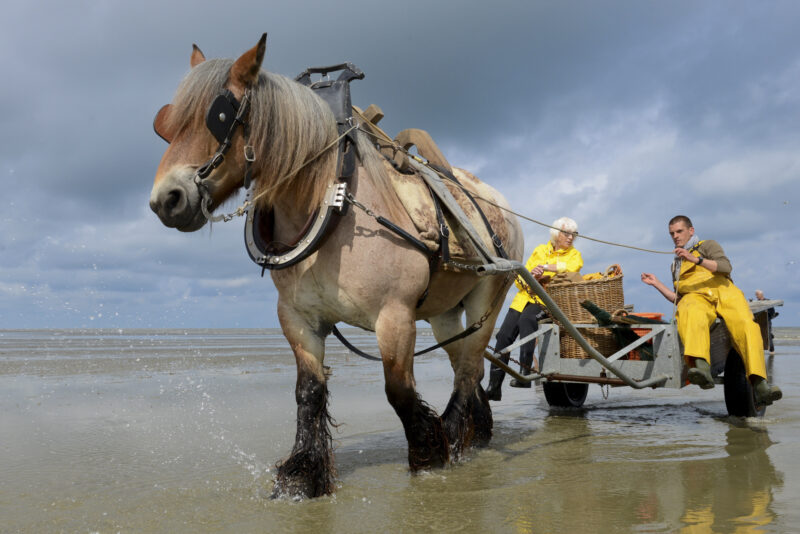Shrimp fishermen on horseback
It's almost low tide in Oostduinkerke, and the shrimp fishermen, dressed in yellow oilskins and high boots, arrive at the beach with their Brabantine draft horses. It's the ideal time to enter the cool waters of the North Sea and bring in a nice catch of gray North Sea shrimp. Watching the shrimp fishermen on horseback at work is a real experience, which is why we decided to head out to sea for a day.
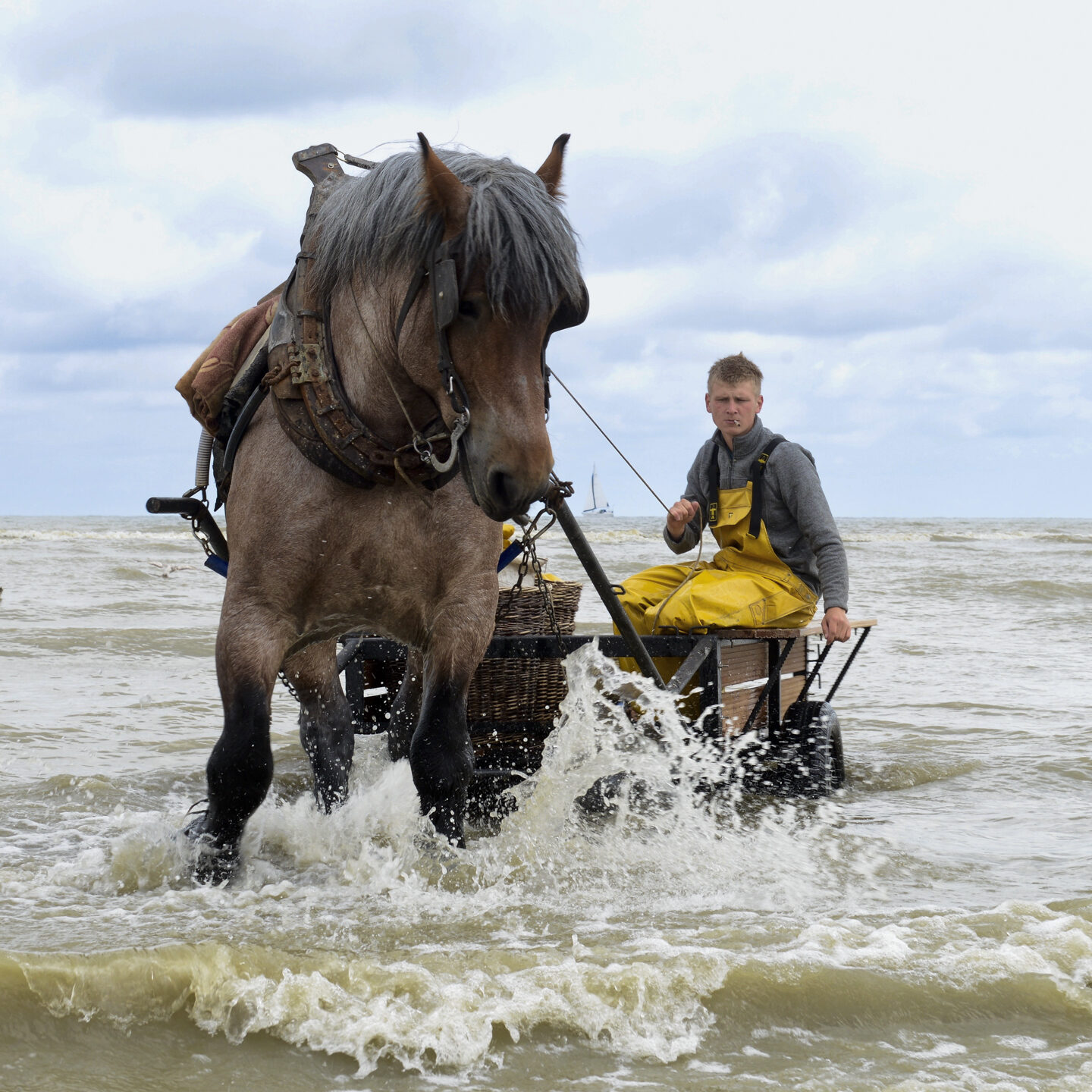
The gray North Sea shrimp
The gray shrimp, Crangon crangon, is a crustacean that lives in the northeastern Atlantic Ocean. It prefers a shallow sandy bottom where it can easily dig burrows. The Belgian beaches along the North Sea are an ideal habitat, and that's also where most gray shrimp fishing happens.
The commercial shrimp fishery
Commercial shrimp fishing is done with beam trawls, which are a rather destructive fishing method. The nets are dragged along the seafloor, and small fish like sole get caught in the nets along with the shrimp. The shrimp caught are sorted, and the small ones are returned to the sea alive. The shrimp are cooked on the fishing boats and taken to auction within 24 hours. Part of the shrimp are taken to processing plants, where they are sprinkled with preservatives and then transported in refrigerated trucks to Morocco to be peeled. By the time they reach the supermarket shelves, it's almost two weeks later. The development of shrimp peeling machines should mean fresher shrimp on our supermarket shelves.
Fortunately, there are also places on the coast where you can buy day-fresh shrimp, like fish mongers or fish markets. Day-fresh shrimp aren't treated with preservatives, so the taste is simply delicious.
How shrimp are cooked (H5).
The way the gray shrimp are cooked aboard fishing vessels gives them their unique taste and texture. Batches of fifteen kilos of shrimp go into boiling seawater with extra salt. When the brine starts to foam, the brine is cooled with some cold seawater. After a few minutes, the cooking liquid foams again. The shrimp are ready!
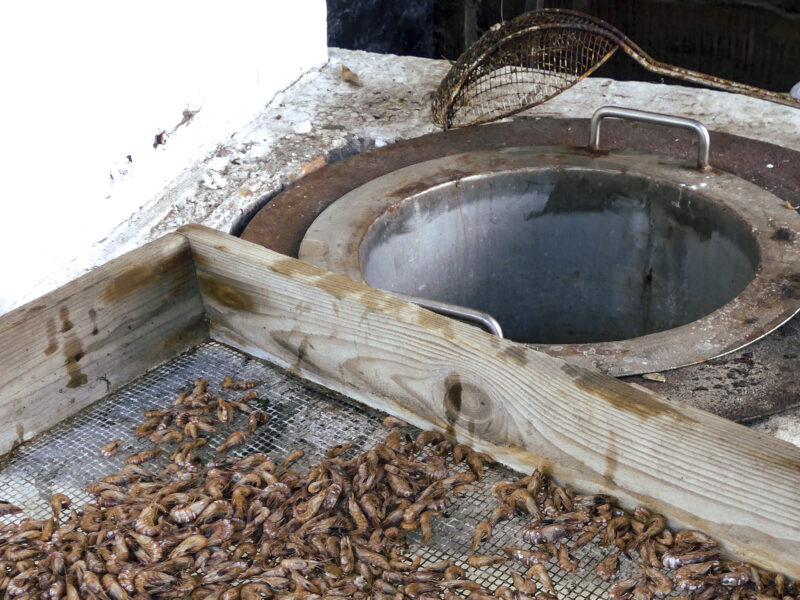
The tradition of shrimp fishermen on horseback
Shrimp used to be fished all along the North Sea coast, from northern France and Flanders to the Netherlands to southern England. Fishermen used to enter the water on horseback, braving the cold along the shores. These days, you'll only find traditional shrimp fishing in Oostduinkerke, a small town on the Belgian coast near the French border. Here, 15 horse fishermen from 12 families still practice this ancient craft, and they're proud of it!
The first mention of shrimp fishing with horses appears in a document from 1563. The document describes "seinvissen," a form of active beach fishing in which two horses pull a large trawl across the sandy seabed.
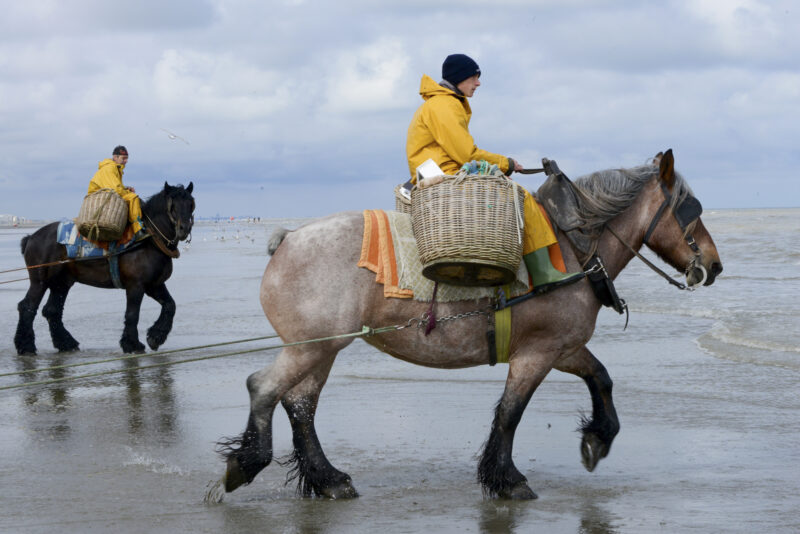
How do you fish for shrimp on horseback?
The horses are led to the water's edge and readied for the catch. The shrimp fisherman attaches a wicker basket to each flank of the horse and puts a cushion of straw and burlap on its back to use as a saddle. He also attaches the ropes leading out to a funnel-shaped net with two rectangular wooden boards. This keeps the net open during the catch. It's time to head out. The shrimp fisherman gets up on the huge horse and rides it out into the sea.
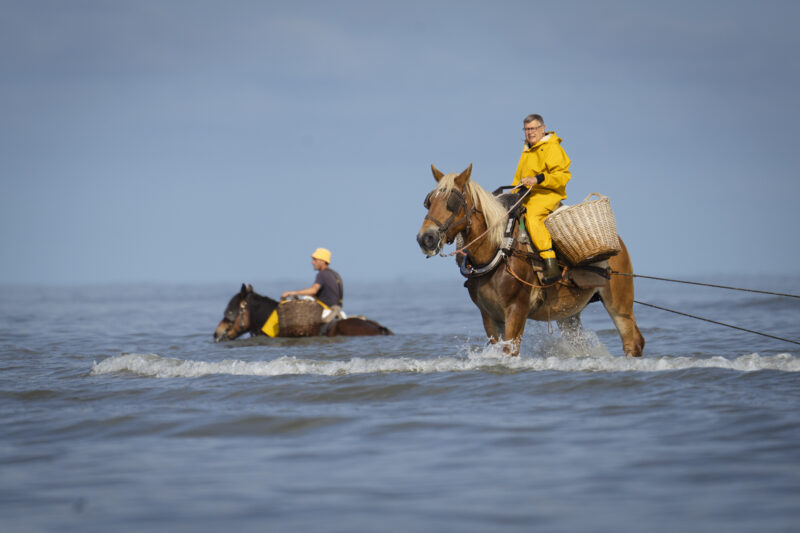
The horses go into the water up to their chests and plow through the waves horizontally with the shoreline. The cables make the shrimp jump out of their burrows in the sand, straight into the net. After about half an hour of fishing, the fishermen return to the beach. They empty the nets into the baskets, then get the horses back in the water. A full catch takes about three hours, from an hour and a half before the low tide to an hour and a half after.
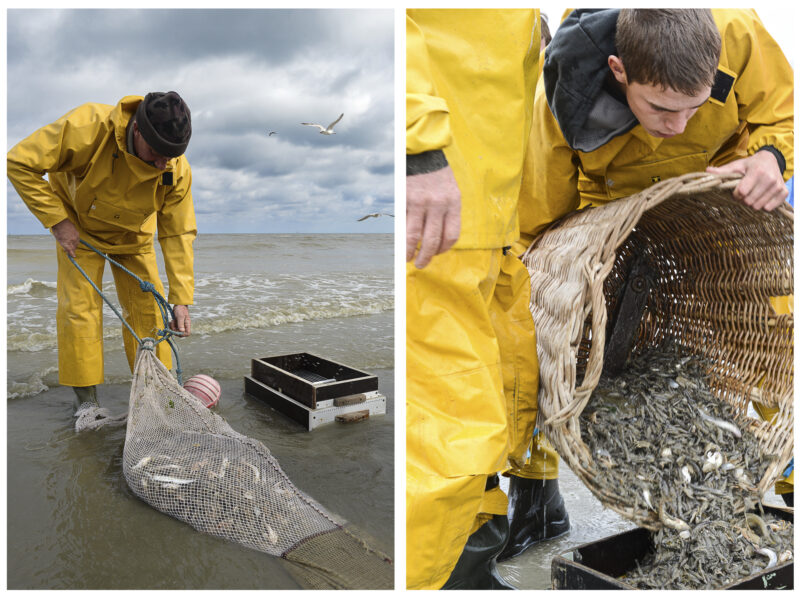
The Brabantine draft horse
Shrimp fishermen use Brabantine draft horses to catch gray shrimp. They're huge, weighing in at over a ton and looking a lot like English Clydesdales. These gentle animals are incredibly strong and can handle heavy work. Brabantine draft horses used to be essential on farms, which is how they got the nickname "farm horses."
The trust and friendship between farmers, fishermen, or other workers and their horses is really important on the job. It's crucial for the handler to be familiar with the terrain where the horse is working. That way, they can safely lead the animal without risking any harm.
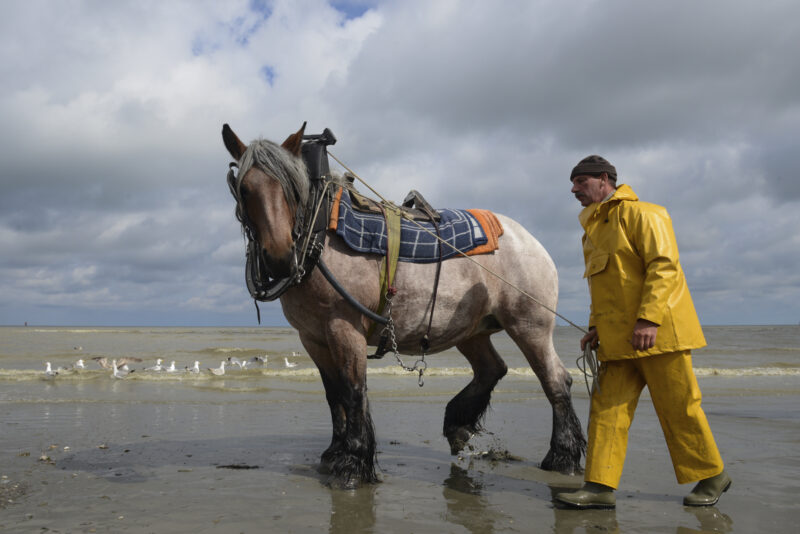
Best period to catch shrimp
The shrimp fishery is largely dependent on shrimp migration. For the commercial shrimp fishery, the season runs from August to October. This is the best time to catch the shrimp, when they are at their largest and hide not too deep in the sand.
The tides and sea currents are additional key factors to consider when fishing for shrimp on horseback. Fishing generally starts from mid-March to June, but the best catches are typically in October and November. In winter, the seawater is too cold for the horses and fishermen, and the shrimp are too deep down in the sand. In the summer, the beach water is too warm for the shrimp, so they migrate to deeper waters.
UNESCO World Heritage Site
Shrimp fishing on horseback in Oostduinkerke has been on the UNESCO list of Intangible Cultural Heritage of Humanity since 2013.
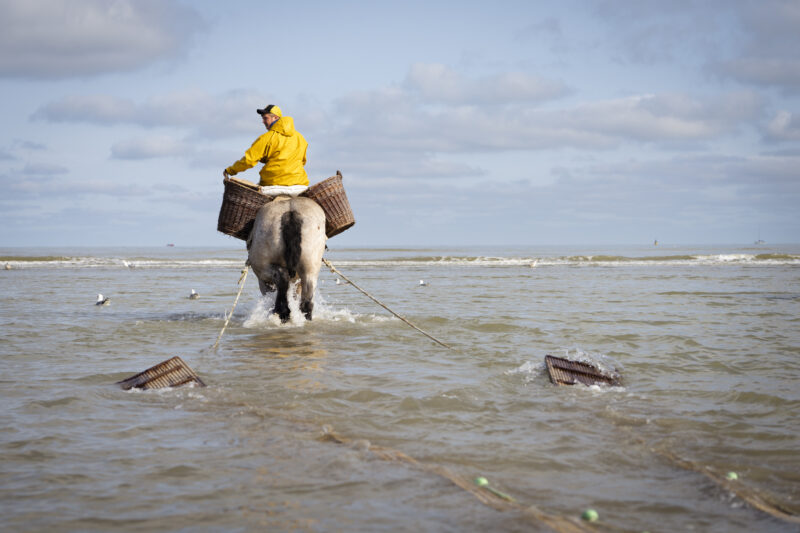
The Stienestekers, the legendary fisherwomen
Another method for catching gray shrimp on the beach is using stake nets. This is still done by the female shrimp fishermen, or Stienestekers, who go far out into the surf with large nets to catch shrimp.
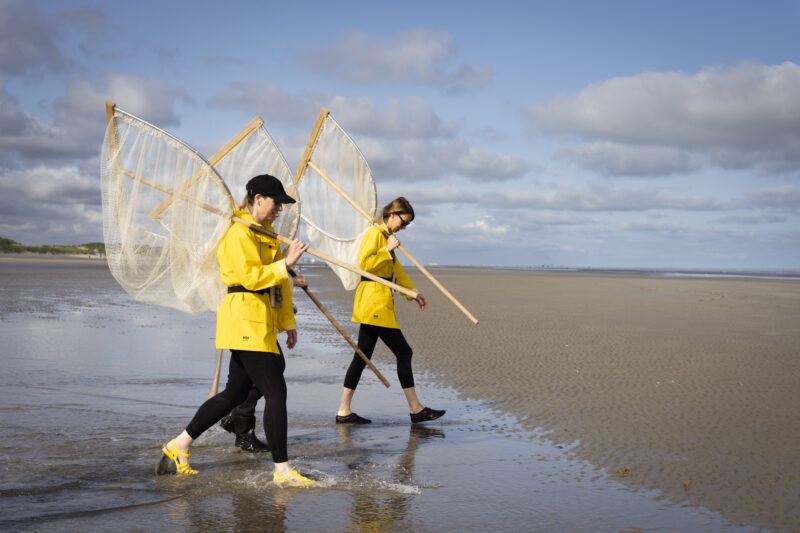
The original Stienstekers
In the past, fisherwomen often had to fend for themselves while their husbands were away, sailing as far as Iceland to fish for months at a time. They had to take care of their families on their own and fished for shrimp to make some extra money.
The women used large nets attached to a stick, which they pushed with their torso. The top of the stick was held in the hollow of a wooden board that they wore with a rope around their necks. They also carried a basket to empty the nets into. To brave the cold seawater, they wore their husbands' old pants, even tucking a worn blanket in during cold weather. The female shrimpers were named after Stiene, who was one of the first women to fish for shrimp by herself.
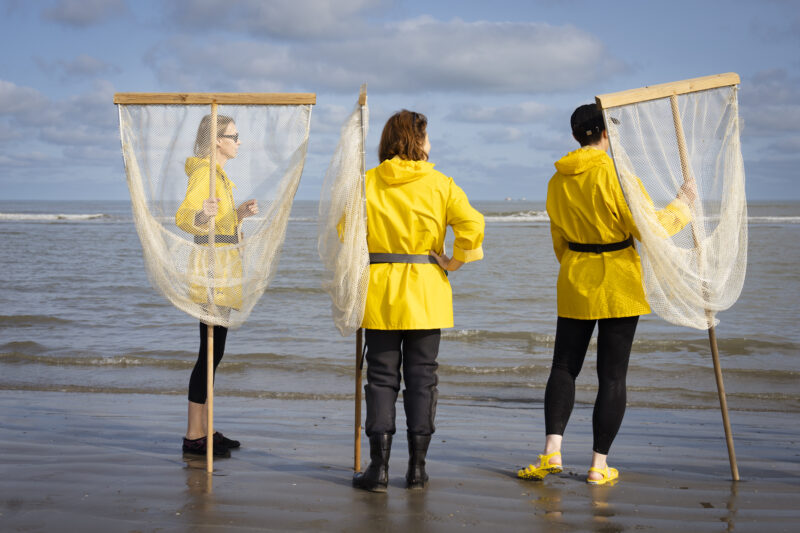
The modern Stienstekers
The craft was sadly lost in the 20th century, but thankfully restored about a decade ago by the dedicated women of the Merchant Union of Oostduinkerke-Bad. These inspiring women accompany the horse fishermen to the beach and in turn go shrimping up to their waists in the seawater. They form a fun and friendly group and are really passionate about sharing their love for the local tradition.
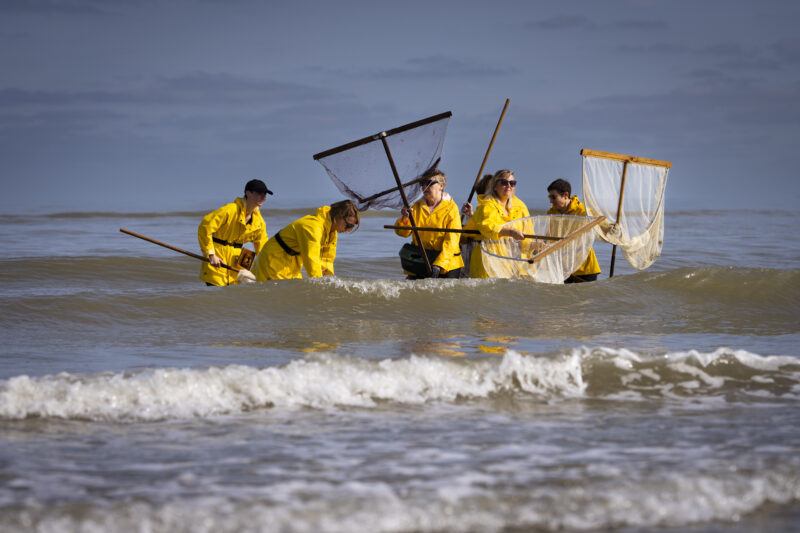
The best places to taste gray shrimp
There are tons of restaurants along the coast and inland serving up delicious dishes with gray shrimp. It'd be impossible to list them all!
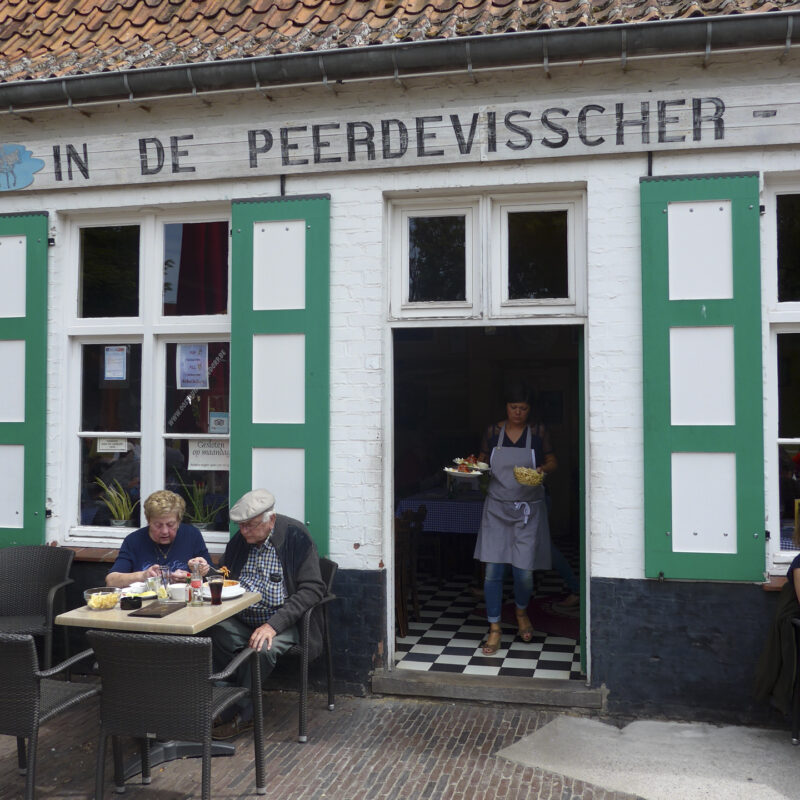
If you get a chance, I'd highly recommend checking out the Estaminet De Peerdevisscher in Oostduinkerke. This historic inn is full of charm and serves some of the region's best shrimp croquettes and fried sole. The business is run by a family of "peerdevisschers" who have been fishing for gray shrimp on horseback for over 50 years. Born in 1917, Jules Durant, known as "the red-headed Durant," loved shrimp fishing and passed on his passion for this ancient craft to future generations. The Peerdevisscher is very popular and doesn't take reservations. I suggest arriving before noon if you don't want to wait in line. During the summer months, there's a large terrace in the courtyard in front of the inn.
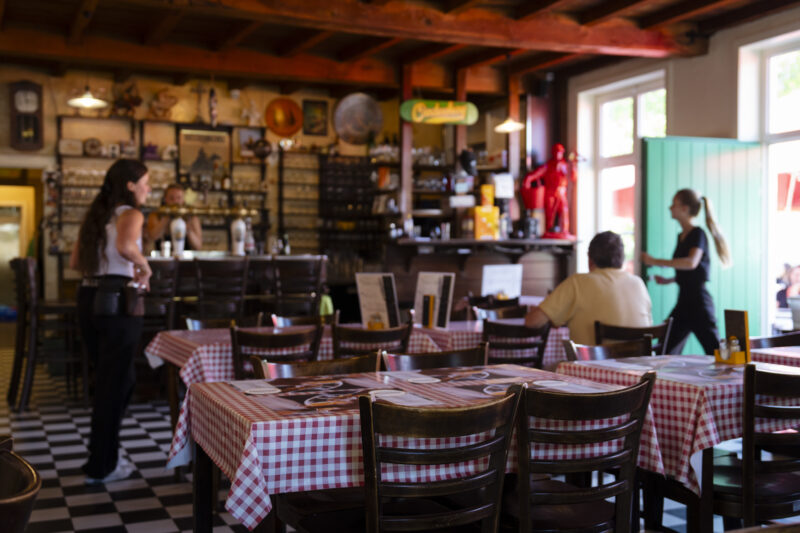
If you're in our capital city, Brussels, you should check out Au Vieux Saint Martin on Place Sablon. They have a great selection of traditional Belgian dishes with gray shrimp, like shrimp salad, shrimp omelette, shrimp toast, and of course, shrimp croquettes. The croquettes are made with shrimp bisque, and the salad has lots of fresh shrimp. It's a popular place but the service is quick and efficient, and the wait is never too long.

Some Practical Tips
During the summer months, shrimp fishermen on horseback hold demo days. You can watch them at work and also have a chat with them about their craft, and you can even stroke the horses. This is a great activity for kids. On some days, the shrimp catch is cooked right there on the dike and sold to any bystanders who'd like to buy it.
If you'd like to know more about when you can see the shrimp fishermen on horseback at work, just get in touch with the Tourist Office of Koksijde-Oostduinkerke or check out the fishing museum Navigo website.
